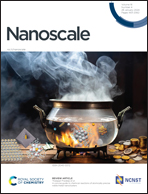Anti-tumor effect of pH-sensitive drug-loaded nanoparticles optimized via an integrated computational/experimental approach†
Abstract
The acidic pH of tumor tissue has been used to trigger drug release from nanoparticles. However, dynamic interactions between tumor pH and vascularity present challenges to optimize therapy to particular microenvironment conditions. Despite recent development of pH-sensitive nanomaterials that can accurately quantify drug release from nanoparticles, tailoring release to maximize tumor response remains elusive. This study hypothesizes that a computational modeling-based platform that simulates the heterogeneously vascularized tumor microenvironment can enable evaluation of the complex intra-tumoral dynamics involving nanoparticle transport and pH-dependent drug release, and predict optimal nanoparticle parameters to maximize the response. To this end, SPNCD nanoparticles comprising superparamagnetic cores of iron oxide (Fe3O4) and a poly(lactide-co-glycolide acid) shell loaded with doxorubicin (DOX) were fabricated. Drug release was measured in vitro as a function of pH. A 2D model of vascularized tumor growth was calibrated to experimental data and used to evaluate SPNCD effect as a function of drug release rate and tissue vascular heterogeneity. Simulations show that pH-dependent drug release from SPNCD delays tumor regrowth more than DOX alone across all levels of vascular heterogeneity, and that SPNCD significantly inhibit tumor radius over time compared to systemic DOX. The minimum tumor radius forecast by the model was comparable to previous in vivo SPNCD inhibition data. Sensitivity analyses of the SPNCD pH-dependent drug release rate indicate that slower rates are more inhibitory than faster rates. We conclude that an integrated computational and experimental approach enables tailoring drug release by pH-responsive nanomaterials to maximize the tumor response.


 Please wait while we load your content...
Please wait while we load your content...